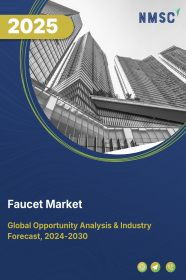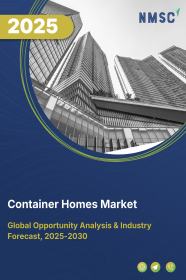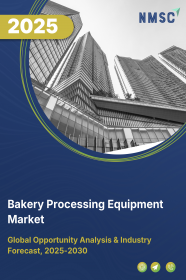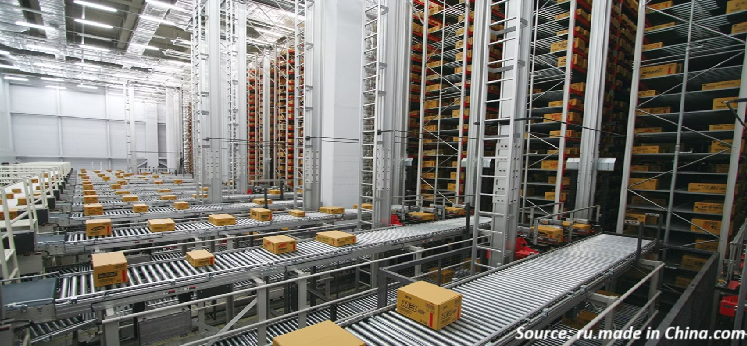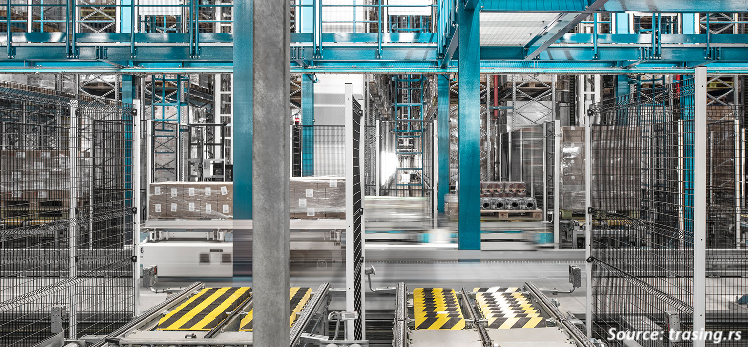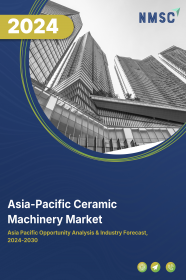
Asia-Pacific Ceramic Machinery Market by Type (Shaping Machines, Decorative and Glazing Machines, Kilns and Firing Machines, Raw Material Processing Machines, Storage and Handling Machines, and Others Machinery), by Product Type (Tile, Sanitary Ware, Tableware, Technical Ceramics, Refractories, and Abrasive), and by End User (Construction, Automotive, Electronics, and Others) – Global Opportunity Analysis and Industry Forecast, 2024–2030
Industry: Construction & Manufacturing | Publish Date: 16-Oct-2024 | No of Pages: 117 | No. of Tables: 110 | No. of Figures: 75 | Format: PDF | Report Code : CM2789
Asia-Pacific Ceramic Machinery Market Overview
The Asia-Pacific Ceramic Machinery Market size was valued at USD 2.13 billion in 2023, and is predicted to reach USD 2.88 billion by 2030, at a CAGR of 3.9% from 2024 to 2030. The ceramic machinery industry, also known as the ceramic manufacturing equipment industry, encompasses designing, producing, and distributing equipment for making ceramic products such as tiles, sanitary ware, tableware, and advanced ceramics.
This market includes a variety of machines including crushers, grinding mills, kilns, dryers, and presses, used throughout the ceramic production process, from preparing raw materials to creating the final product.
Ceramic manufacturing equipment is known for its high precision, enabling accurate shaping, glazing, and manufacturing of ceramics, leading to consistent quality and reduced labor costs. The market supports the growing demand for sophisticated ceramic products through advancements in technology and increased automation investments, enhancing production capabilities and operational efficiency.
Rising Construction Industry Drives Demand for Ceramic Machinery in the Asia-Pacific
The growth of the construction market across the Asia-Pacific region significantly boosts the demand for ceramic machinery. As construction projects for residential, commercial, and industrial buildings expand, the need for a diverse range of ceramic products, such as tiles and sanitary ware, increases. This rising demand necessitates advanced ceramic manufacturing equipment that ensures efficient production processes and maintains high-quality standards.
The ongoing expansion in construction activities in Asia-Pacific highlights the critical role of modern machinery in meeting the growing production needs and supporting the overall development of the ceramic machinery market.
Rising Electronics and Semiconductor Industries Drives Demand for Ceramic Components
The burgeoning electronics and semiconductor industries in the Asia-Pacific region are driving up the demand for high-precision ceramic components. These industries require sophisticated ceramic machinery capable of producing highly accurate and reliable components essential for advanced electronics.
As technology progresses and the need for precision components rises, manufacturers are investing in cutting-edge machinery to meet these stringent production requirements. This trend underscores the importance of advanced manufacturing equipment in supporting the growth and technological advancements within the electronics and semiconductor sector.
High Initial Investment Hindering Growth of the Ceramic Machinery Market
A major challenge facing the Asia-Pacific ceramic machinery market growth is the high initial investment required for advanced equipment. This financial burden poses a significant barrier, especially for smaller companies and startups, limiting their ability to invest in cutting-edge technologies.
The considerable capital necessary for purchasing and installing sophisticated machinery restricts these businesses from upgrading their operations or expanding their capabilities. Consequently, this financial constraint hampers the overall Asia-Pacific ceramic machinery market expansion, as it prevents a broad range of manufacturers from accessing new and more efficient production technologies that could drive the industry forward.
Integration of Inkjet Technology in Ceramic Machinery Creates Future Opportunities
The integration of inkjet technology into ceramic processing presents an exciting opportunity for market expansion. This innovative technology allows for high-resolution, customizable printing directly on ceramic surfaces, enabling the creation of intricate designs, vibrant colors, and detailed patterns.
The use of inkjet technology enhances the aesthetic appeal and personalization of ceramic products, catering to increasingly sophisticated consumer preferences. Additionally, it streamlines production processes by reducing the need for traditional, labor-intensive methods, thereby improving efficiency and reducing costs.
This advancement not only offers a competitive edge but also opens up new avenues for growth within the ceramic manufacturing equipment sector, making inkjet technology a valuable investment for future market development and innovation.
China Holds the Dominant Market Share in Asia-Pacific Ceramic Machinery Market
The growth of the construction industry in China significantly boosts the demand for ceramic products like tiles, sanitary ware, and decorative elements, driving the Asia-Pacific ceramic machinery market demand.
Advanced ceramic machinery is essential for manufacturing these high-quality products by automating and optimizing production processes, enhancing efficiency, precision, and scalability.
According to the International Trade Administration's 2023 report, China leads the global construction market, with infrastructure investments projected to reach approximately USD 4.2 trillion during the 14th Five-Year Plan period (2021-2025).
The surge in construction projects, spanning residential, commercial, and infrastructure developments, elevates the need for durable and visually appealing ceramic materials, further propelling the Asia-Pacific ceramic machinery market growth.
Urbanization in China also accelerates the demand for ceramic machinery. As cities expand, there is an increased need for construction and renovation projects. The International Institute for Environment and Development's 2024 report highlights that rapid urbanization has led to an urban population increase of 491.1 million, with over 60% of the population living in urban areas by 2022.
This urban growth drives higher demand for ceramic products for new residential, commercial, and public buildings, prompting manufacturers to invest in advanced machinery to meet these needs efficiently and with high quality. This growing demand for ceramic products fuels the expansion of the advanced ceramic machinery industry in China.
Singapore to Witness Substantial Growth in the Asia-Pacific Ceramic Machinery Market
The substantial electronic industry in Singapore significantly boosts the demand for ceramic machinery due to the need for precise and high-quality components. Advanced ceramics are vital for manufacturing a variety of electronic components, including semiconductors, capacitors, insulators, substrates, and piezoelectric devices, which are essential for smartphones, computers, automotive electronics, and medical devices.
According to the latest report from the Ministry of Trade and Industry Singapore (MTI), the electronics sector is the largest segment within Singapore's manufacturing industry, contributing 46.9% to the sector's nominal value-added (VA) and 9.7% to the nation's overall GDP in 2022. Ceramic machinery is crucial for achieving the precision, efficiency, and quality required to meet the rigorous standards of the electronics industry.
Additionally, the increase in ceramic exports drives the demand for efficient and high-capacity production capabilities. In 2023, Singapore exported ceramic roofing tiles with a trade value of USD 30.01 thousand and a quantity of 59,995 kilograms globally.
The growing demand for ceramic products requires investment in advanced machinery to ensure the precision, quality, and volume necessary for competitive export markets. This machinery enables producers to scale operations, maintain product consistency, and adhere to stringent export standards, thereby driving growth in the ceramic machinery sector in the country.
Competitive Landscape
Several market players operating in the Asia-Pacific ceramic machinery industry include SACMI, KEDA Industrial Group Co., Ltd., SYSTEM Ceramics, HANDLE GmbH Maschinen und Anlagenbau, Yutai Machinery Technology Co., Ltd, VIJAY SURGICAL & ENGG. WORKS, Shandong Victor Advanced Material Technology Co., Ltd., LB Technology, SITI B&T Group S.p.A., MODENA TECHNOLOGY LIMITED, and others.
Asia-Pacific Ceramic Machinery Market Key Segments
By Type
-
Shaping Machines
-
Decorative and Glazing Machines
-
Kilns and Firing Machines
-
Raw Material Processing Machines
-
Storage and Handling Machines
-
Others Machinery
By Product Type
-
Tile
-
Sanitary Ware
-
Tableware
-
Technical Ceramics
-
Refractories
-
Abrasive
By End User
-
Construction
-
Automotive
-
Electronics
-
Others
By Country
-
China
-
Japan
-
India
-
South Korea
-
Australia
-
Indonesia
-
Singapore
-
Taiwan
-
Thailand
-
Rest of Asia-Pacific
Key Players
-
SACMI
-
KEDA Industrial Group Co., Ltd.
-
SYSTEM Ceramics
-
HANDLE GmbH Maschinen und Anlagenbau
-
Yutai Machinery Technology Co.,Ltd
-
VIJAY SURGICAL & ENGG. WORKS
-
Shandong Victor Advanced Material Technology Co., Ltd.
-
LB Technology
-
SITI B&T Group S.p.A.
-
MODENA TECHNOLOGY LIMITED
REPORT SCOPE AND SEGMENTATION:
|
Parameters |
Details |
|
Market Size in 2023 |
USD 2.13 Billion |
|
Revenue Forecast in 2030 |
USD 2.88 Billion |
|
Growth Rate |
CAGR of 3.9% from 2024 to 2030 |
|
Analysis Period |
2023–2030 |
|
Base Year Considered |
2023 |
|
Forecast Period |
2024–2030 |
|
Market Size Estimation |
Billion (USD) |
|
Growth Factors |
|
|
Countries Covered |
10 |
|
Companies Profiled |
10 |
|
Market Share |
Available for 10 companies |
|
Customization Scope |
Free customization (equivalent up to 80 working hours of analysts) after purchase. Addition or alteration to country, regional, and segment scope. |
|
Pricing and Purchase Options |
Avail customized purchase options to meet your exact research needs. |

















 Speak to Our Analyst
Speak to Our Analyst



